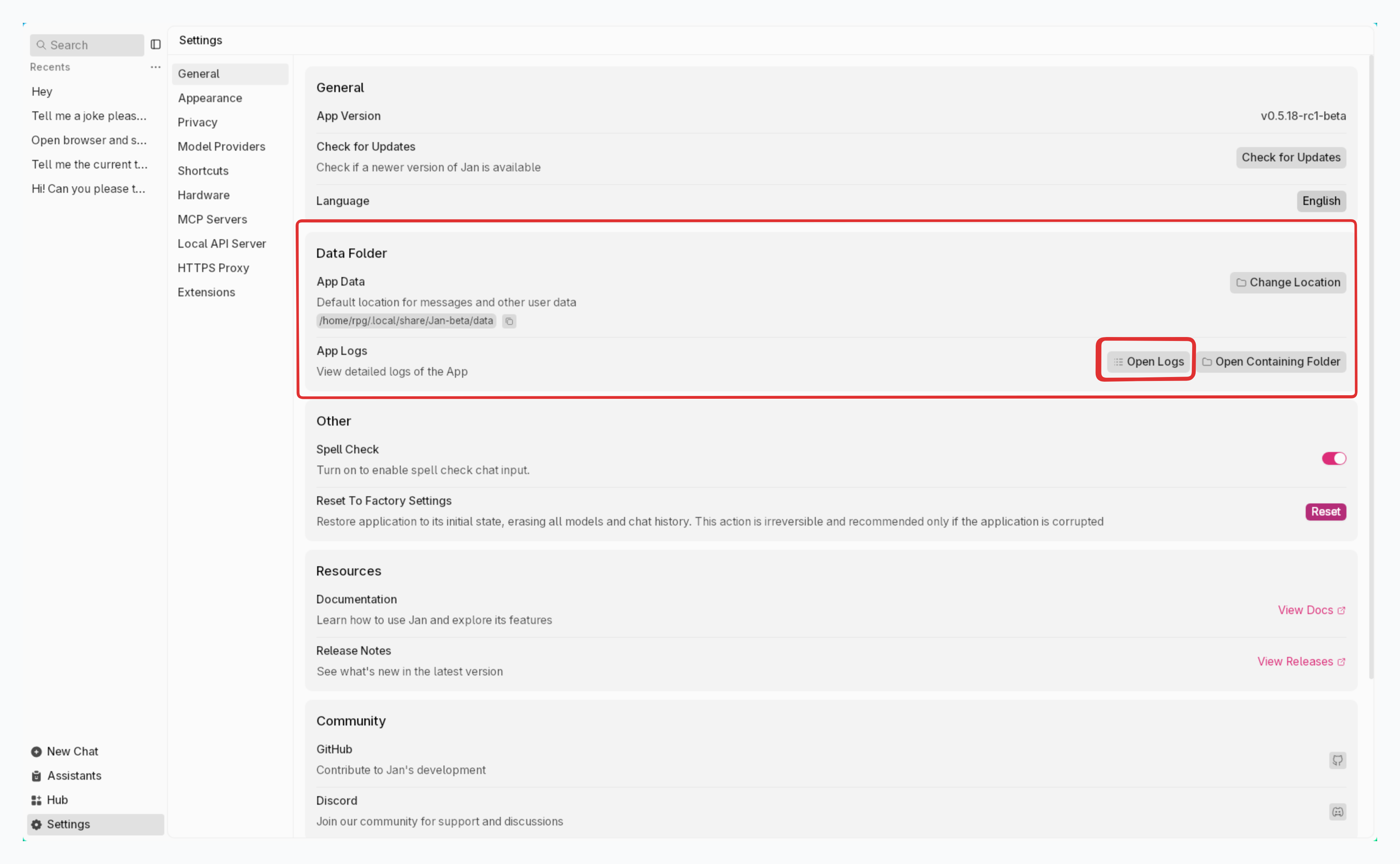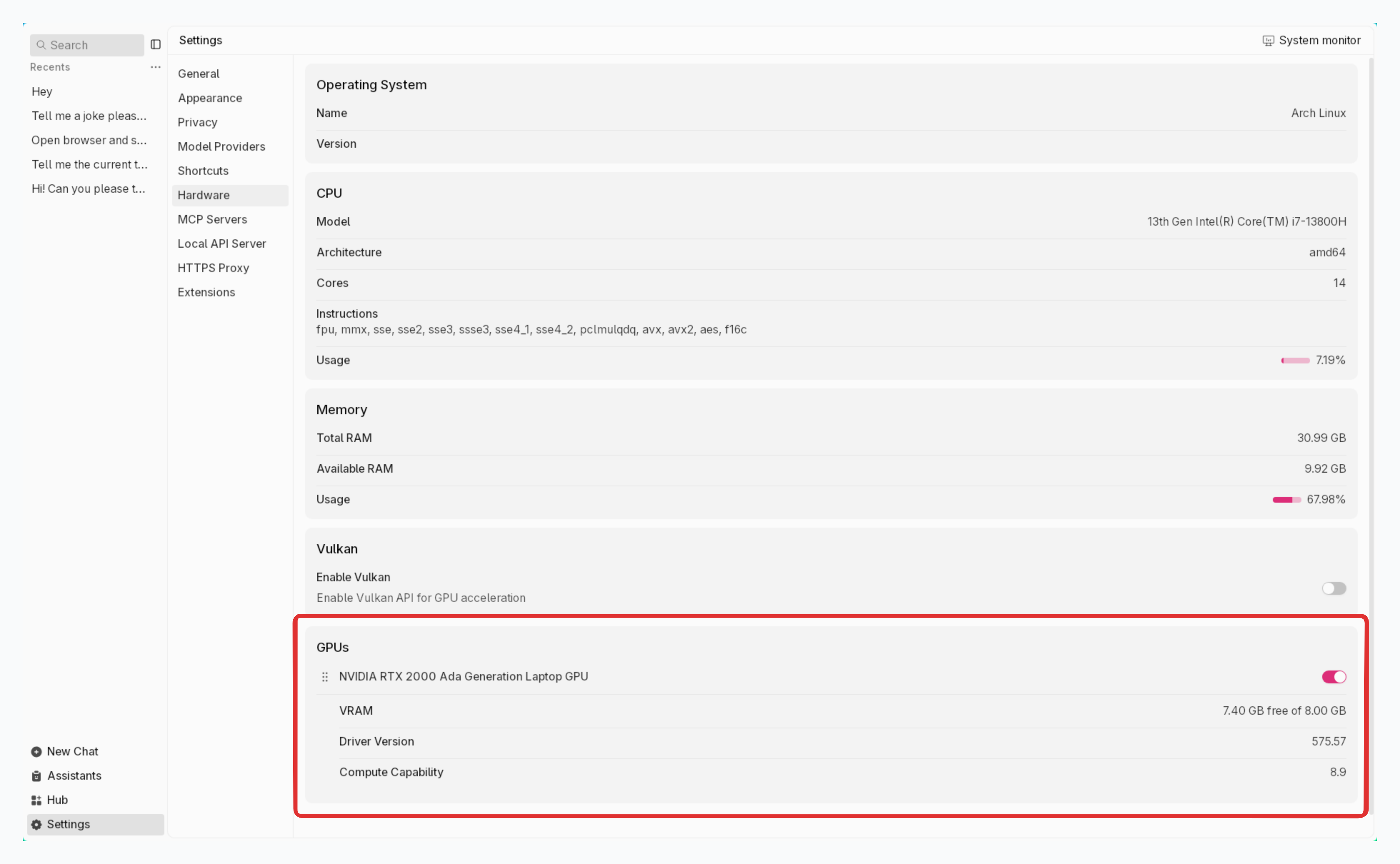Troubleshooting
Getting Help: Error Logs
When Jan isn't working properly, error logs help identify the problem. Here's how to get them:
Quick Access to Logs
In Jan Interface:
- Look for System Monitor in the footer
- Click App Log

Via Terminal:
# macOS/Linuxtail -n 50 ~/Library/Application\ Support/Jan/data/logs/app.log# Windows type %APPDATA%\Jan\data\logs\app.log
Remove any personal information before sharing logs. We only keep logs for 24 hours.
Common Issues & Solutions
Jan Won't Start (Broken Installation)
If Jan gets stuck after installation or won't start properly:
Clean Reinstall Steps:
-
Uninstall Jan from Applications folder
-
Delete all Jan data:
rm -rf ~/Library/Application\ Support/Jan
- Kill any background processes (for versions before 0.4.2):
ps aux | grep nitro# Find process IDs and kill them:kill -9 <PID>
- Download fresh copy from jan.ai
Make sure Jan is completely removed from all user accounts before reinstalling.
NVIDIA GPU Not Working
If Jan isn't using your NVIDIA graphics card for acceleration:
Step 1: Check Your Hardware Setup
Verify GPU Detection:
Windows: Right-click desktop → NVIDIA Control Panel, or check Device Manager → Display Adapters
Linux: Run lspci | grep -i nvidia
Install Required Software:
NVIDIA Driver (470.63.01 or newer):
- Download from nvidia.com/drivers (opens in a new tab)
- Test: Run
nvidia-smiin terminal
CUDA Toolkit (11.7 or newer):
- Download from CUDA Downloads (opens in a new tab)
- Test: Run
nvcc --version
Linux Additional Requirements:
# Install required packagessudo apt update && sudo apt install gcc-11 g++-11 cpp-11# Set CUDA environmentexport LD_LIBRARY_PATH=$LD_LIBRARY_PATH:/usr/local/cuda/lib64
Step 2: Enable GPU Acceleration in Jan
- Open Settings > Hardware
- Turn on GPU Acceleration
- Check System Monitor (footer) to verify GPU is detected

Step 3: Verify Configuration
- Go to Settings > Advanced Settings > Data Folder
- Open
settings.jsonfile - Check these settings:
{ "run_mode": "gpu", // Should be "gpu" "nvidia_driver": { "exist": true, // Should be true "version": "531.18" }, "cuda": { "exist": true, // Should be true "version": "12" }, "gpus": [ { "id": "0", "vram": "12282" // Your GPU memory in MB } ]}
Step 4: Restart Jan
Close and restart Jan to apply changes.
Tested Working Configurations
Desktop Systems:
- Windows 11 + RTX 4070Ti + CUDA 12.2 + Driver 531.18
- Ubuntu 22.04 + RTX 4070Ti + CUDA 12.2 + Driver 545
Virtual Machines:
- Ubuntu on Proxmox + GTX 1660Ti + CUDA 12.1 + Driver 535
Desktop installations perform better than virtual machines. VMs need proper GPU passthrough setup.
"Failed to Fetch" or "Something's Amiss" Errors
When models won't respond or show these errors:
1. Check System Requirements
- RAM: Use models under 80% of available memory
- 8GB system: Use models under 6GB
- 16GB system: Use models under 13GB
- Hardware: Verify your system meets minimum requirements
2. Adjust Model Settings
- Open model settings in the chat sidebar
- Lower the GPU Layers (ngl) setting
- Start low and increase gradually
3. Check Port Conflicts If logs show "Bind address failed":
# Check if ports are in use# macOS/Linuxnetstat -an | grep 1337# Windowsnetstat -ano | find "1337"
Default Jan ports:
- API Server:
1337 - Documentation:
3001
4. Try Factory Reset
- Settings > Advanced Settings
- Click Reset under "Reset To Factory Settings"
This deletes all chat history, models, and settings.
5. Clean Reinstall If problems persist, do a complete clean installation (see "Jan Won't Start" section above).
Permission Denied Errors
If you see permission errors during installation:
# Fix npm permissions (macOS/Linux)sudo chown -R $(whoami) ~/.npm# Windows - run as administrator
OpenAI API Issues ("Unexpected Token")
For OpenAI connection problems:
1. Verify API Key
- Get valid key from OpenAI Platform (opens in a new tab)
- Ensure sufficient credits and permissions
2. Check Regional Access
- Some regions have API restrictions
- Try using a VPN from a supported region
- Test network connectivity to OpenAI endpoints
Performance Issues
Models Running Slowly:
- Enable GPU acceleration (see NVIDIA section)
- Use appropriate model size for your hardware
- Close other memory-intensive applications
- Check Task Manager/Activity Monitor for resource usage
High Memory Usage:
- Switch to smaller model variants
- Reduce context length in model settings
- Enable model offloading in engine settings
Frequent Crashes:
- Update graphics drivers
- Check system temperature
- Reduce GPU layers if using GPU acceleration
- Verify adequate power supply (desktop systems)
Need More Help?
If these solutions don't work:
1. Gather Information:
- Copy your error logs (see top of this page)
- Note your system specifications
- Describe what you were trying to do when the problem occurred
2. Get Community Support:
- Join our Discord (opens in a new tab)
- Post in the #🆘|jan-help channel
- Include your logs and system info
3. Check Resources:
When sharing logs, remove personal information first. We only keep logs for 24 hours, so report issues promptly.